|
FAQs about Sea Slugs, the
Opisthobranchs, Identification
2
Related Articles: Sea Slugs, Nudibranchs,
Related FAQs: Seaslug
Identification 1, Seaslug ID 3,
Seaslug ID 4, Seaslug ID , Seaslugs 1, Seaslugs 2, & FAQs
on: Seaslug
Behavior, Seaslug
Compatibility, Seaslug
Selection, Seaslug Systems,
Seaslug Feeding, Seaslug Disease, Seaslug Reproduction, & Marine Snails 1, Marine Snails 2, Marine Snails 3, Nudibranchs, Nudibranchs 2, Nudibranch Identification, Nudibranch Behavior, Nudibranch Compatibility, Nudibranch Selection, Nudibranch Systems, Nudibranch Feeding, Nudibranch Disease, Nudibranch Reproduction, Berghia Nudibranchs, Snail ID 1, Snail
ID 2, Snail ID
3,
|
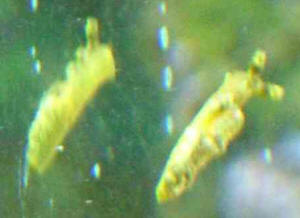
|
|
Help ID Tank Spaghetti 11/14/08 Dear
Crew, <Hello Andy.> It's been a long time since I
rapped at you. I've been out of the loop because my tank
crashed in September and I haven't had much to write about
<Sorry to hear about that.> -my only inhabitants are a Kole
Tang, a Sea Hare (Aplysia californica) that I borrowed from my
LFS to deal with the incredible amount of algae that plagued my
tank after the crash from (I assume) all the nutrients that were
released when $3k worth of fish and coral disintegrated, and a
bunch of hermits and snails. I know this Sea Hare is a temperate
water species and will eventually starve in my tank, which is why
I borrowed it rather than purchased it--I needed something big to
eat an incredible amount of algae. Anyway, as I mentioned there
is very little in my tank--I am letting my tank settle/re-mature
and don't want to load it up with any fish for a few months.
Almost nothing survived the crash, so almost all life other than
the above is new that came in on a few new pieces of LR and some
bristleworms, etc. that I transferred from my other tank. So,
imagine my surprise when I found the attached on the underside of
a piece of live rock tonight. This mass looks like a handful of
spaghetti (same thickness and about 4" in diameter). It
appears to be some type of egg mass, but the only thing that
could have deposited it is the Sea Hare. Am I right on this?
<Absolutely. These are sea hare eggs. Thanks for sharing. Do
you know the National Resource for Aplysia at the University of
Miami? You'll find information on the lifecycle, larval
stages there. Rearing procedures are also briefly described on
their website http://aplysia.miami.edu.> Thanks! Andy
<Welcome. Marco.>
|
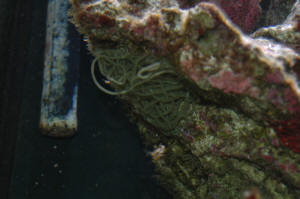 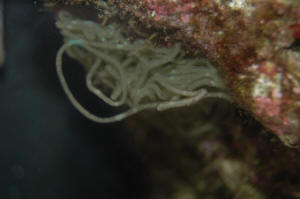 |
|
Help ID Tank Spaghetti II 11/14/08 Wow,
thanks Marco. Does this mean I'm going to have 8 million Sea
Hares in my tank? <No, are they fertilized at all? I thought
you only got a single specimen.> In the normal tank, would
most get eaten by fish, corals, etc? <Even if you had two and
the eggs were fertilized, few would have a chance. Not all would
be eaten, the rest would be filtered, skimmed. If you want to
raise sea hares you need at least two, and contact the National
Resource for Aplysia and see their site for Aplysia
production.> Thanks again. Andy. <Cheers, Marco.>
Help ID Tank Spaghetti III 11/14/08 I
assume they are not fertilized--I have only one specimen, and I
have had it for 4 weeks or so. I have no interest in raising Sea
Hares. Thanks for your help. <Welcome. Marco.>
|
Nudi? Possible Sea Slug -- 5/3/08 Hi guys <Hi
Ian, Lynn here this morning.> I think I saw a Nudibranch but not
sure. It was highlighted on the front glass panel otherwise would never
have noticed. It was a tiny yellowish worm looking slug which was about
10mm in length and 2mm wide. It was moving like a Nudi and had two
little feelers on its head. <It does sound like a sea slug of some
sort.> Please help me to ID this and if a Nudibranch could it be a
pest? <Sorry, Ian, but without a good photo I can't even begin
to narrow down the search. As far as it being a possible pest, it's
undoubtedly a pest to something, but what I have no clue. A lot of
these guys are obligate feeders, feeding on one specific food item and
that's it. Once that food source disappears, so do they. Have you
noticed any damage to your resident corals/cnidarians (if you have
any)? If not, chances are good that this little slug isn't too much
cause for concern. You may see it out an about for a bit and then no
more.> I have not recently introduced anything into the tank but at
this size it could have been around for a long time without being
noticed. <Many are nocturnal but can be seen in systems during the
day when they're running out of food. Also, some are cryptically
colored/adorned so that they blend in unbelievably well with their
surroundings - which in quite a few cases is what they eat!> Your
help is appreciated. <You're very welcome, Ian. For more
information and help in narrowing down the possibilities, please see
the following links (as well as the highlighted links at the tops of
the WWM pages): Sea Slugs:
http://www.wetwebmedia.com/seaslugsopisthobranchs.htm Nudibranchs:
http://www.wetwebmedia.com/nudibran.htm Sea Slug Forum:
http://www.seaslugforum.net/ > Cheers Ian <Good luck! Take care,
-Lynn>
Re: Nudi? Possible Sea Slug -- 5/3/08 Hi Lynn
<Hi Ian> Thanks for your prompt response. Will check out the web
pages you sent. <Sounds good. What you want to do is look for shared
traits in the species of sea slugs/Nudibranchs shown at the WWM links I
provided. That should help you narrow the search to family level. After
that, go to the Sea Slug Forum and compare each individual species
listed under that family. It can be tedious and time consuming, but
ultimately rewarding! Here's a quick link to the SSF species list:
http://www.seaslugforum.net/specieslist.cfm > Cheers for now Ian
<Take care and let me know if you're able to ID that little
fellow! --Lynn)>
| Please ID: Sea Slug - 4/19/08 <Hi
Cynthia> I am new to Nano-reefs. I actually went into the LFS to
buy a small freshwater tank and ended up walking out with a 14g
Bio-Cube. <Nice!> Please ID this weird white slug/worm that
was hitchhiking on a turban snail. It's now on my live rock.
I've exhausted myself searching the web and looking at photos
of worms, snails, slugs. It does have 2 hornlike tentacles on its
head. <Unfortunately, I can't see enough of the little guy
to tell exactly what it is other than a sea slug of some sort. You
might want to look through the various families/genera at WWM for
shared/common traits including general shape, ornamentation on the
back, shape of rhinophores (hornlike tentacles on the head), etc.
Then go through the individual species listed under that family or
genus at the Sea Slug Forum (link listed below). Also, keep in mind
that these creatures do vary in color and can even fade and turn
white if they're starving. Identifying sea slugs can be a big
challenge, but you should be able to narrow it down to family given
the links below. Also, be sure to go over part 3 of Bob's
Nudibranch article for more general information regarding keeping,
etc. http://www.wetwebmedia.com/nudibran.htm
http://www.wetwebmedia.com/seaslugsopisthobranchs.htm
http://www.seaslugforum.net/ Species list at SSF:
http://www.seaslugforum.net/specieslist.cfm > Thanks Cynthia
Rice <You're most welcome and good luck on your search!
-Lynn> |
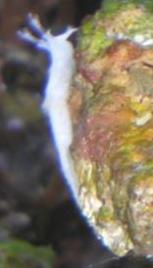
|
|
Infected Tank??? Aplysiid sel.
4/1/08 Hi Bob, <Cynne> Hope this finds you well. Once
again I have encountered a question regarding stock. The tank is
the same as I described before. I now have 90 % of the Scorpions
on frozen food, as well; I have followed your advice and
purchased the Aqua C Remora Protein Skimmer with Mag 3 pump. I
also have increased to a 4-6 inch sandbed with some aragonite.
The Scorpions are so much fun :) I cannot believe that I enjoy
them even more than the seahorses. <Both have/exhibit
interesting behavior for sure> I no longer have the starfish;
I sacrificed him about 2 months ago for a CopperSafe ich
treatment (entire tank). I had to choose between the $17.00
starfish or the $1000.00 fish. I have since changed all filter
media, changed 100% of the water in 25% intervals over a couple
of weeks and rebuilt the biological with rock rubble from the
LFS. I also continue to run poly filters and charcoal in the Aqua
Clear. My question is I recently purchased a sea hare. I have
always wanted one, but was afraid of inking. <Mmm, not an
issue with many... tropical species. Unfortunately there is a
current rush of selling large, non-tropicals...> I have
searched your site but am still unsure as to what I have.
According to one of Anthony's replies, I found that any Sea
Hare with tassels is Carnivorous? <Mmm, no... not a sure
characteristic> The pet store said this one was a Herbivore
and they weren't sure regarding toxins. I also found one
currently running on EBay and according to the seller; this guy
isn't toxic
http://cgi.ebay.com/NANO-Hairy-Sea-Hare-Reef-Aquarium-Live-HAIR-ALGAE_
W0QQitemZ290207618335QQihZ019QQcategoryZ66788QQrdZ1QQssPageNameZWD1VQQ_
trksidZp1638.m118.l1247QQcmdZViewItem. They also advertise this
as a Nano size, Yet he looks a lot like the one on your FAQS page
2nd photo. <Mmmm... is this Bursatella leachii? Am thinking
so... get's a bit large for nanos, but is tropical...> I
bought him in NC, I am desperately hoping he is not a cold water
species. He is fat bodied brown to green in color with black
splotches. He also has baby blue specks all over the body and
head, as if someone splashed paint on him, and he is tasseled.
Please help I can get whatever food he needs. I just need to know
what to expect. The fish do not mess with him at all and all
intakes on filters and power heads are covered. Thanks again for
all your advice!! You guys are great!! Cynne <Do see the Net
(Google images et al.) for pix, ID... BobF out in Borneo>
Re: Infected Tank??? Seahare ID
4/4/08 Hi Bob, Thanks to all of you once again for quick
response and intelligence beyond compare. You pegged it!!
Bursatella Leachii he is. I could not find him on your site, and
the internet was still a little contradicting. So what to feed?
Life expectancy? Toxicity? Thanks Again Enjoy Borneo!! Cynne
<I know naught other than what can be found on the Net also...
did collect/culture Aplysia californica years back... but this is
about all of the group. BobF, done diving and headed back
tomorrow>
|
|
Surprise critter: Sea Slug? ID sources -
1/5/08 Hi all, <Hi Richard!> First, thanks for sharing
so much info on WWM - it's a big help! <Thank you,
it's our pleasure!> I've just set up my first marine
tank (after 20 years of FW tropical). <Such a wonderful,
rewarding hobby -- welcome to reefkeeping!> It's been
cycling for nearly 2 weeks. I kicked the cycling off with about
4kgs of LR, which I'm told came off the Victoria coast (Oz -
I'm in Melbourne). <Lucky you! I am determined to get to
Australia one of these days. The Great Barrier Reef has always
been at the top of my list of places to see/explore.> Ammonia
and nitrates are currently at 0ppm, although nitrites are at 2.5.
<Will subside/cycle out.> I've got a healthy supply of
copepods & amphipods flourishing already, also some snails.
<Yay!> Tonight I happened to pass the tank with the lights
off and spotted something strange on the back glass. I turned on
the lights and saw what appears to be a small sea-slug.
Unfortunately due to the amount of algae starting to grow
already, my camera wouldn't focus, so no photo I'm
afraid. <Darn.> It's a teardrop shape, about 15mm long,
5 mm wide and a brownish red in colour. It has two white feathery
antennae at the thin end of the teardrop and three small white
spots on it's back - almost a small smiley. <Oh I know, I
know! It's the rare and elusive Smiley Nudibranch, family
Smileyidae -- just kidding <g>. Sorry, I couldn't
resist!> It's quite flat, although the centre of the back
is raised about 3 mm. Any suggestions as to what it could be?
<Unfortunately, there are just too many possibilities and
without a photo...?> I'm planning on keeping seahorses in
the tank in another month or so <Go slowly here.> and
I'm trying to avoid nasty surprises. Algae eaters would be
fine though... <Understandable. If it were me, next time I saw
that little guy, I'd get him out of there.> Also, is there
any kind of marine creature search engine on the web into which
you can enter distinguishing features? <Not per se - that
covers all marine creatures. At least, not that I know of.>
Seems like something that would come in very handy for many
people :-) <Yes, indeed! In lieu of one specific search
engine, there are many sites on the web that can help (including
WWM!). I'll give you some of my favorites. The first will be
of particular use for you as it covers crustaceans of southern
Australia. You may find some of the amphipods/copepods/etc.
populating your tank here:
http://museumvictoria.com.au/crust/page1.html Here's another
site that's run by a friend in the Philippines:
http://home2.pacific.net.ph/%7Esweetyummy42/hitchhikers.html This
site is Dr. Shimek's dichotomous key -- very handy indeed!
http://www.ronshimek.com/Invertebrate%20Key%20to%20Major%20Taxa.htm
Great sites regarding Sea Slugs:
http://pick4.pick.uga.edu/mp/20q?guide=Rhabditophora&flags=not_no
http://www.wetwebmedia.com/seaslugsopisthobranchs.htm
http://www.seaslugforum.net/ I hope these help. I've got a
gazillion more on file, but these should get you started!>
Many thanks, Richard <You're very welcome! Take care
-Lynn>
Update: New marine tank with surprise critter - Nudibranch?
Sea Hare - 3/8/08 Hi Lynn, <Hey Richard! How's my
favorite Aussie doing?> Thanks very much for the info you sent
me. <You're very welcome.> The 'smiley slug'
disappeared for a little while, but a couple of weeks ago
surfaced again. <Neat> It's grown somewhat (35mm+)
since I last saw it, and I just wanted to let you know that
I'm now sure it's Dolabrifera dolabrifera, the algae
eating sea hare. <Yay, congratulations and good on you for
figuring out what it is! Thanks, also, for letting me know. Neat
little creatures like this tend to lurk in the back of my mind
until they're identified.> In fact, I seem to have about
five of them, and although the smiley looked quite different when
it was young (appeared to have a smooth back and white markings),
the similarities between the mature hares really make it obvious.
<Awesome> Now that I've watched them in action for a
few weeks, the following are pretty clear: - They don't eat
anything other than algae. - The colours come from the particular
algae that they're eating (slowly changes over a period of 5
- 6 days). Seems likely that the red pigment doesn't
penetrate all parts of the body - he's now pinkish brown with
green ears :-) <Heeeee! It's the Easter Sea Hare!> -
They're indifferent to what colour slug they mate with. -
They're not the smartest critter in the world and often
can't tell the difference between a rock and a seahorse (much
to the surprise of both parties when they go for a ride)
<Wheeeeee! Yep, it doesn't exactly sound like they're
sharpest tacks in the drawer!> Cheers, Richard <Thanks
again, Richard, for following up with this and for sharing your
observations! Take care and have a great weekend, -Lynn>
|
Sea Slug ID: Elysia crispata? Need more information --
2/3/08 <Hi there, Victor!> About one month ago, I acquired
some live rocks from the southern part of Puerto Rico, after curing
them I placed them in my marine aquarium. Last week I noticed an odd
creature, which I assume to be some type of sea slug. It is completely
white in color with two antennas and its back is completely covered
with white corkscrew strands. Two days ago I discovered two more of
these creatures, one measures 1 1/4" and the other two 1". To
my surprise, the larger one merged with one of the smaller species and
today I noticed pasted to the glass what looks like a corkscrew rope in
a circle, I assume these are eggs. <You assume correctly!> At
first I thought that these were Lettuce Sea Slugs (Nudibranch) but this
species is not completely white nor do they have those corkscrew
strands on their backs. My question is: What species are these
creatures and do they represent a threat to my marine community? Almost
forgot, I have never seem them on the bottom, they are always on the
glass and move slowly just like a snail. <Hmmmm, here's one
possibility, Elysia crispata. If that's it, I'm going to go buy
a lottery ticket! Please see these links:
http://www.seaslugforum.net/factsheet.cfm?base=elyscris and
http://www.seaslugforum.net/display.cfm?id=10414 If that's not it
(or if it's close), then an ID is going to take some research. What
I would recommend is to go through the following links and try to
determine which family your sea slug shares the most characteristics
with. Start here: http://www.wetwebmedia.com/seaslugsopisthobranchs.htm
. Then see the three pages starting here:
http://www.wetwebmedia.com/nudibran.htm , especially the section on
page 3 titled 'The Big Three Aquarium Problems with
Nudibranchs'. Once you determine a likely family, you can then go
to the Sea Slug Forum and look through the species listed in that
family: http://www.seaslugforum.net/. It's a lengthy process, but
you might just find your little slugs!> Best Regards and Thanking
you in advance, Victor. <You're very welcome and good luck! Take
care. -Lynn>
Sea Slug Id -- need more info -- 10/11/07 Hi,
<Hi there!> I have a reef aquarium and recently found a sea slug
in it and I am having trouble identifying it.
<Understandable, can be a challenge.>
The closest thing I can find that it resembles is the Janolus cristatus
but I live in Florida in the United States so I am not so sure that it
could possibly be that. <So it was collected locally, then?) The
next closest thing it resembles is the color of Berghia but not
Berghia. It has a wider body with much longer cerata. I assume it is
nocturnal because I have only seen it out at night. <Okay> It
also moves much faster than Berghia. I have Berghia in a separate
aquarium. If you have any ideas about what it could be or could point
me in the right direction I certainly would appreciate it much.
<Well, a photo would be great here, but I can refer you to an
excellent site for research: http://www.seaslugforum.net/. While there,
do go through the species list
(http://www.seaslugforum.net/specieslist.cfm) and check the links for
genus Phyllodesmium, under the Family Glaucidae - as well as these
species for comparison:
http://www.seaslugforum.net/factsheet.cfm?base=dondocci
http://www.seaslugforum.net/factsheet.cfm?base=phidlync
http://www.seaslugforum.net/factsheet.cfm?base=learpoic
http://www.seaslugforum.net/factsheet.cfm?base=learevel > Thanks in
advance, Tariea Haywood <You're welcome, and good luck!
--Lynn>
Sea Hare ID -- 09/25/07 Hi Bob,
<George> We took a shot of this animal and although it seemed
like an Aplysia dactylomela at first we have second thoughts now.
First because it was shot three days ago in the Mediterranean (and
not the Caribbean) and second because it doesn't show the
typical "wings" on its back. <Mmm, yes, but...> Do
you know what this species is ? Needless to say, you can use the
photo for your site (a higher definition photo can be sent to you
if you need it for publication). <Looks like Aplysia dactylomela
to me...> Best regards and many thanks,
George Reclos |
|
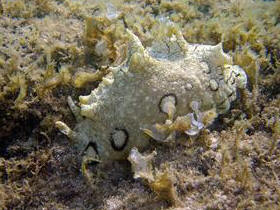
|
| Re: Weird White Pod or Sack on Tank - Looks Like
Something That Was Attached to Alien Or Syconoid Sponges Identity
Crisis - Dying Gracilaria -- 5/19/07 <Hello Earthling,
now called Dan, Mich with you again.> Hmmm, I think the problem
is one in the same Mich. More in depth look in the
fuge. This pod seems to turn into a two antennae white
slug. <Mmm, nope! You have two different creatures
here. Sea Slugs and Syconoid sponges> I've seen
two crawling in the fuge...very small & they appeared white.
<These Sea Slugs look to be of the order Sacoglossa or
Sap-Sucking slugs which feed mainly on algae. Likely
they are part of the genus Elysia. More here: http://www.wetwebmedia.com/seaslugsopisthobranchs.htm
> This one in the pic was in the tank... not so white.
<Perhaps greenish?> Also is a pic of what I would call a
bunch of Pupa entwined in the Gracilaria. <Nope, still Syconoid
sponges.> Thanks with the help. <Welcome!> Man I am
scratch'n for an answer... <I won't ask
where...> with out the Gracilaria, my nitrates are beginning to
rise. <Gracilaria can be a challenge to grow. If
it's growing sponges, it's not tumbling enough.> I could
put Chaeto in there but would that be fuel for these things as
well? <No, but Chaeto or Caulerpa may be a better food source
for the slugs which can be difficult to keep in
captivity. Mich> DanH Picture Too
Large! 5/18/07 <Please return with a smaller picture
attached. This one is overloading out
bandwidth. Thanks, WWM Crew> <No worries.> |
|
 .jpg)
|
| Help ID this slug 5/10/07
Some people on Reef Central think it's a slug but not sure what
type or if it is reef safe. Could it be a Sea Hare? I found it at
night underneath my Molokai LR. Does it eat algae? Thanks. <Is a
Common Sea Hare (or Kualakai in Hawaiian), Dolabrifera dolabrifera
(Rang, 1828), Family Aplysiidae... Do feed on algae, live under
rocks intertidally! Nice pix! Bob Fenner> |
|
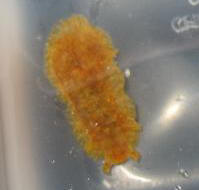 .jpg)
|
|
|

